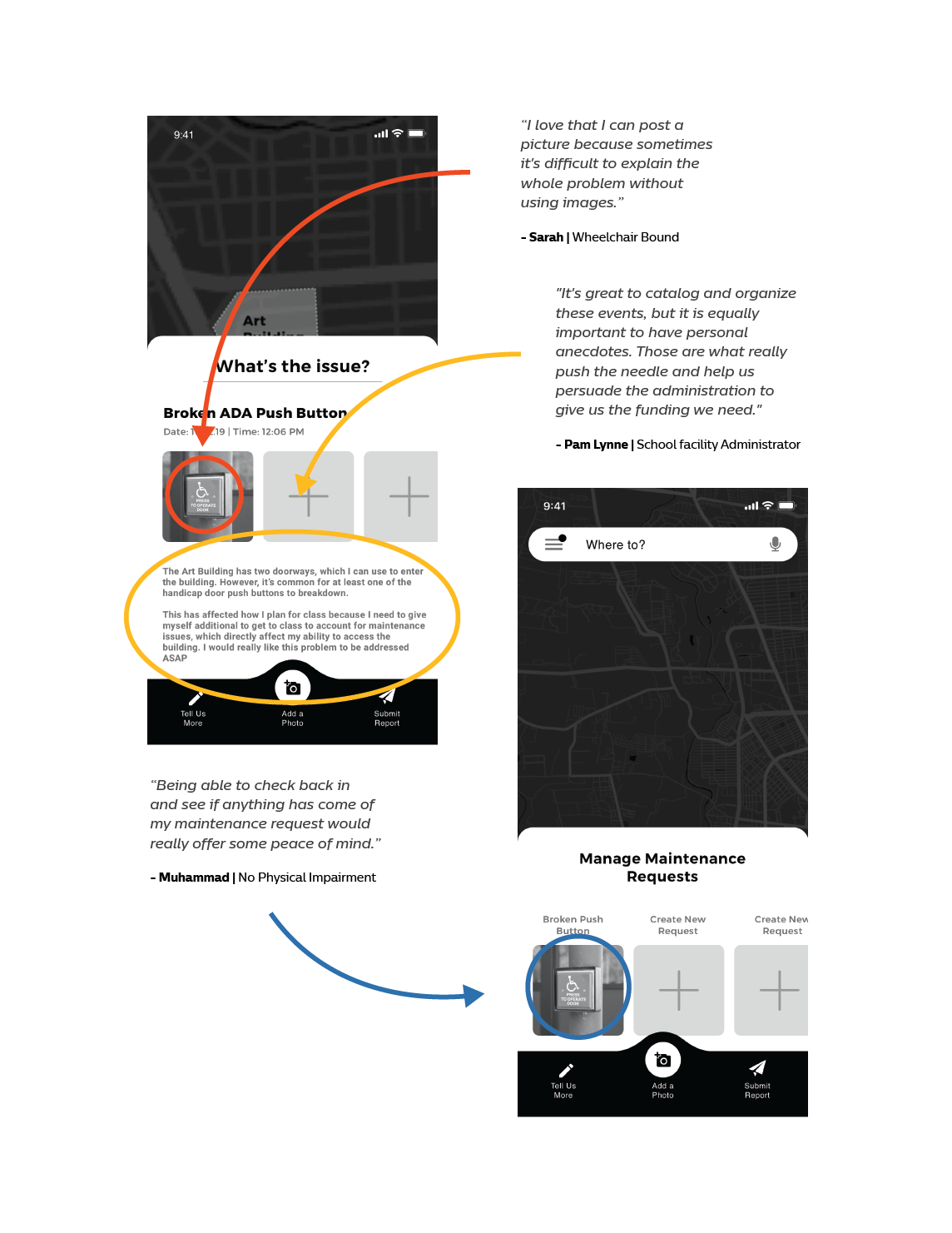
Maintenance Maps
Maintenance should be about more than preserving facilities. It should entail advocating for and upholding the experiences of people who rely on it most.
Design Process Overview
1. Defining Maintenance
I learned about key stakeholders experiences’ and strategies utilized to identify and fix problems.
4. Ideating Solutions
I did a few round of quickfire concept ideation. I then selected the intervention I felt best addressed the problem.
2. Finding Key Stakeholders
I used various design methods to gain insight into how stakeholders are affected by maintenance.
5. Developing a Prototype
I developed Lo-Fi prototypes and then brought the concept back to my participants to see if it addressed their needs.
3. How Might We
I synthesized my research using affinity diagrams. I then defined the problem and developed a How Might We statement.
6. Delivering a Solution
Based on user testing I made changes and proceeded by creating high-fidelity prototypes illustrated through CUJ’s.
Expert Interviews
I began my research by speaking with experts about maintenance at the University of Washington. Below I listed my main takeaways
Addressing facility maintenance directly impacts the overall accessibility of campus.
It is difficult to identify all maintenance needs on campus.
The school has adopted a piecemeal approach to resolving maintenance requests
Based on my interviews, I decided to focus on how maintenance affects the accessibility of spaces. By using this as a starting point, I can improve everyone’s experience, including those who are most vulnerable to poorly maintained facilities.
Stakeholder Interviews
Sarah | 24 | Wheelchair Bound
Sarah is a student who uses a wheelchair to get around campus.
The building on campus, which she spends the majority of her time, has two doorways she can use to enter the building. However, Sarah said that it is common for at least one of the Handicap Door Push Buttons to breakdown.
Sarah claimed that she feels that when preparing for classes, she needs to give herself additional to get to class to account for potential maintenance issues.
Muhammad | 52 | No Physical Impairments
Muhammed is a faculty member at the University of Washington.
Muhammed does not have a physical disability, but at times feels unsafe on campus.
In describing the photos, he took Muhammed said, “Seattle is a rainy place to live, it’s also extremely hilly. To get from the parking lot to my office, I have to climb like 100 steps.”
Looking at the photos, he took Muhammad then pointed a place that he fell one night when walking to his car.
Luckily he wasn’t injured but also said that he had no idea who to notify, and because the problem was never addressed it has always remained in the back of his mind when he walks to his office
Jeff | 36 | Temporarily Scouter Bound
Jeff is a graduate student at the UW. He usually walks to school but is currently unable to use stairs, and as a result, has had to find a new route to get to campus.
The new route uses cutbacks, and as a result, is three times the distance.Because Jeff’s new route takes so much longer, he no longer walks home with friends, as he usually would.
Jeff claimed that this has led to increased isolation and irritation but also said that he didn’t know who tell or if anything could be done.
Natasha | 21 | Hearing Impaired
Natasha is a student at the University of Washington and has a hearing impairment.
Natasha told me that every classroom on campus has different acoustics and that this affects her ability to engage with classmates and teachers.
While she knows particular rooms make it incredibly difficult to engage, she is unsure of how to improve the situation, stating, "It's not like I can ask everyone to get up and use the classroom across the hall."
HOW MIGHT WE
How might we advocate for and enhance the experiences of individuals who rely on the facilities at the University of Washington?
Problem:
It is unclear who to tell when encountering a maintenance problem on campus.
It is difficult to catalog and organize problems.
Individuals with physical disabilities are disproportionately impacted by how well facilities are maintained
Current attempts to solve problems fail to account for the whole picture and thus could be handled more efficiently.
Ideation
I did a few round of quickfire concept ideation. I then grouped sketches, and selected one which best addressed the problem. After considering a variety of interventions I selected Maintenance Maps. I made this decision based on the following criteria:
Engages primary and secondary stakeholders
Offers a Lightweight solution that leverages existing user bases (and thus reach)
LoFi Prototype
I selected the concept which best served the users and addressed the core problems. I then created low-fidelity mockups to explore Critical Users Journeys.I presented my prototypes back too all of my participants to see if they felt the solution addressed their needs. Based on their responses I added, changed and removed certain features.
Design Solution
Maintenance should be about more than preserving facilities. It should entail advocating for and upholding the experiences of people who rely on it most.
Usability
Testing
I presented my prototypes back too all of my participants to see if they felt the solution addressed their needs. Based on their responses I added, changed and removed certain features.















